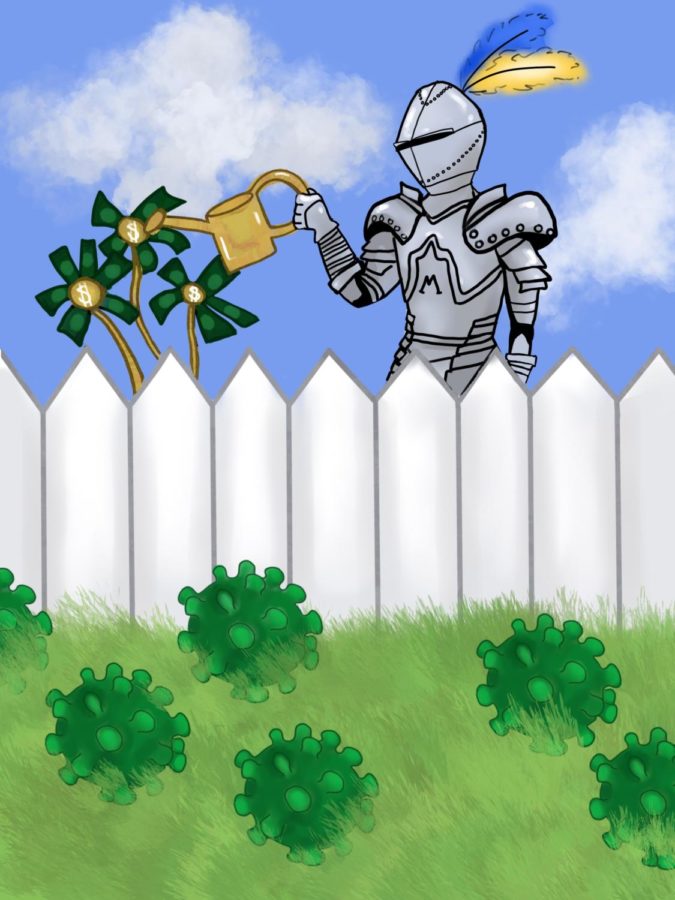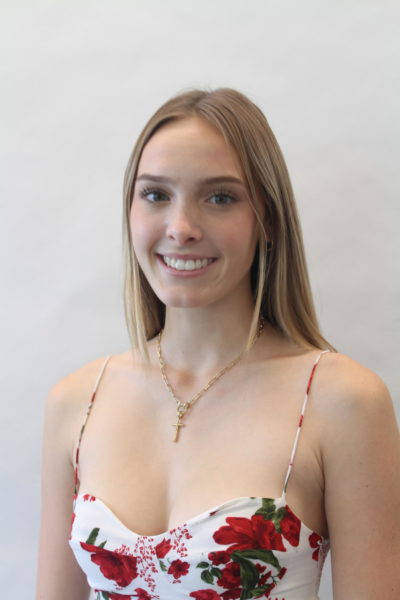Menlo’s Myopic Lense: How Wealth Has Skewed COVID-19 Understandings at Menlo
Menlo students have a warped perception of COVID-19. Staff illustration: Tatum Herrin.
March 12, 2022
Sometimes, tragedy brings us together. Other times, it cracks the earth and leaves fissures between us. Tragedy can also walk the delicate line between these two impacts. During the pandemic, we are all vulnerable; no one is wholly immune to the virus or looming stay-at-home orders. We can find comfort in knowing that fear of sickness and the looming threat of loss are shared experiences. But on the contrary, COVID-19 has also displayed our self-preserving nature as American citizens and as humans. The pandemic has shed light on the glaring wealth disparities in the US, especially Silicon Valley, and has displayed the capabilities of different communities to handle COVID-19. Menlo students have observed that the Menlo community takes a distinct, myopic perspective on COVID-19, influenced by the comfort wealth.
Menlo sophomore Maddie Brown explained how her experience during distance learning has varied from her friends’ experiences at local public schools like Menlo-Atherton High School and Palo Alto High School. “In terms of my education, [COVID-19 has] allowed me to focus a lot more academically,” she said. “[Public schools] don’t really have the same resources as Menlo, and their classes are a lot bigger, so it’s harder to make online school accessible for everyone,” she said. Lower-budget schools struggle more with distance learning than schools like Menlo, impacting the long-term learning of children in lower-income families, according to the Los Angeles Times. Due to a lack of resources, many students of these schools have fallen behind in their studies.
According to an article in the Almanac, Menlo-Atherton High School was completely online for all of the previous school year. Menlo students, on the other hand, were able to attend class in-person for several weeks of the second semester last school year thanks to on-campus testing and plenty of open space. But even when forced to stay at home, distance learning wasn’t the end of the world for most Menlo students. The majority of us have access to a stable internet connection, printer and quiet space at home to learn. Menlo students were able to pick up their own “science kits” from school, engaging in lab-based learning despite being stuck at home.
For many Menlo students, our understanding of the issue is reduced to our own experiences. Both Menlo senior Griffin Perks and Brown know several Menlo students who broke quarantine knowing they had COVID-19. Perks recognizes that, earlier in the pandemic, he wasn’t as careful as he now wished he was. “It’s hard to take something [seriously] when you haven’t had it,” Perks said. “For the first year and a half, I knew maybe one family that had [COVID-19], so I didn’t really think it was that big a deal. And I’m also a kid, so I knew it wouldn’t affect me. […] I didn’t consider the severity of the issue, which made it easier for me to slack off,” he said.
Countless Menlo students still maintain this subconscious mindset, the mindset that their personal experiences with COVID-19 are universal and the mindset that COVID-19 isn’t all that big of a deal. For many students, Menlo has become an echo chamber of this belief.
For a Menlo student, getting COVID-19 is an entirely different reality than the average American. When most Menlo students get COVID-19, they don’t have to worry about having to stay home from work or school for a month, losing their source of income, and being incapable of putting food on the table. Most don’t have to worry about falling seriously ill, and not having the resources to be treated.
While it is true that the death rate of the omicron variant is significantly lower than the original strand of COVID-19, the U.S. remains in the midst of a dangerous and highly infectious disease. On the week of Jan. 8, 2022, there were 7,833 deaths involving COVID-19 in the U.S., according to the CDC.
Further, anxiety from illness is removed by the padding of wealth to a certain extent. Many Menlo students are not concerned with access to testing, medicine and professional medical attention. “[Getting a COVID-19 test at Menlo is] super easy. It takes two minutes max. It’s just whether or not the kids remember it or want to take two minutes out of their day to do it,” Perks said. “[My friends at public school] are baffled that we have testing done at our school. It’s something we’re really fortunate to have.” W Conflicting federal guidance and a national shortage of rapid-test kits caused many districts to struggle with ramping up or establishing in-school testing programs. In many areas, schools were unequipped to provide testing and forced to close according to the New York Times.
Brown has heard Menlo students hope they contract the virus, joke about contracting it and even travel on planes after contracting the virus as if the spread means nothing. This kind of behavior reflects the warped perspective many Menlo students maintain and their lacking awareness of how COVID-19 can affect those different from them.




John Doe • Apr 13, 2022 at 8:29 pm
This article represents everything that is great about Menlo’s newspaper: entitlement, privilege, blind acceptance of private school–supremacy, and a complete lack of editorial prejudice.
Despite its self-reflective aims, this article was almost amazing in the lengths it went to preserve the egos of Menlo students and parents. Blinded by self-awareness, the author confidently misses the point time and time again to a degree that one would almost think comedic… yet it was somehow an attempt at authentic journalism.
Let us start from the beginning. The first paragraph is accurate and true. If the author did one thing right in this essay, it was that Menlo students have absolutely no concept of what it is like to live, go to school with, and interact with, those with less, due to the hyper-wealthy bubble-within-a-bubble that is the privatized Menlo campus.
[paragraph redacted]*
First of all, while Menlo does have a lower class size than most area public schools, this had little to no effect on virtual classes or in-person classes. In fact, many area public schools have abnormally-low class sizes compared to the national average. Next, the author claims that “‘[l]ower-budget schools struggle more with distance learning than schools like Menlo, impacting the long-term learning of children in lower-income families,’ according to the Los Angeles Times.” This is the confident misrepresentation I referenced earlier—this is not even close to what the referenced LA Times article was saying. The article was saying that distance learning universally harms those of a lower-income background—this article doesn’t mention private schools once. The author hit the ball out of the completely wrong ballpark—it isn’t the fact that the school is public that is causing the student to fail. It is instead the student’s underprivileged background. The insinuation that Menlo is, therefore, better than a public school, is insultingly stupid. This is not a valid opinion or “perspective,” as the Menlo newspaper values so much. Instead, this is a desperate attempt to justify the absurd price of tuition to the students and parents of Menlo. One last thing; public schools aren’t low budget, at least around here. Menlo’s budget is just ridiculously high.
In the third paragraph, the author notes that “Menlo-Atherton High School was completely online for all of the previous school year. Menlo students, on the other hand, were able to attend class in-person for several weeks of the second semester last school year thanks to on-campus testing and plenty of open space.” First of all… “plenty of open space?” It’s not like public schools are smaller than private schools… I digress. The main issue with this passage is the appalling level of cherry-picking employed by the author. While some public schools did not return at all last year, many did, including Woodside and Sequoia. No points for you, Menlo.
In the penultimate paragraph, the author once again assaults the intelligence of the reader with her ridiculous assertion that only Menlo students have access to healthcare: “Many Menlo students are not concerned with access to testing, medicine and professional medical attention. ‘[Getting a COVID-19 test at Menlo is] super easy. It takes two minutes max. It’s just whether or not the kids remember it or want to take two minutes out of their day to do it,’ Perks said. ‘[My friends at public school] are baffled that we have testing done at our school. It’s something we’re really fortunate to have.’” First of all, Menlo students have no better access to testing than most area public school kids do; while they did develop a testing program fairly early, for a long time now, schools like Woodside have offered free weekly testing for all those who want it. If you look at it a certain way, public schools’ COVID-19 testing services are even more accessible than Menlo’s, given the conspicuous lack of a $40k per year fee. You don’t get that point either. Sorry. Also, the implication that Menlo provides students with free medicine and “professional medical attention” is patently false. Menlo students have to debase themselves by going to the same facilities that plebeian public school kids have to go to.
The author then goes on to say that “a national shortage of rapid-test kits caused many districts to struggle with ramping up or establishing in-school testing programs.” But I thought that we just got saying that Menlo established their testing program earlier than public schools did… so how did they get the tests? And wouldn’t public schools need the tests more due to a higher number of underprivileged kids at public schools, the same kids who, as mentioned, need the tests more? It’s almost as if Menlo was paying for tests that public schools can’t obtain so that they can administer them to the kids that need them the least…
The most fundamental argumentative atrocity committed by this article was alluded to earlier; this supposition that there are two types of student—the privileged Menlo student and the underprivileged public school–goer—is dangerous and moronic. This article depicts public schools as bleak, underfunded, and dangerous places, despite their actual thriving, well-run nature. This sad attempt by the Menlo newspaper to slander public schools as less-than is evil, deplorable, and unbecoming of any serious journalist.
Some last-minute tips: It’s LENS, not LENSE. There should be an “of” after “comfort.” And the absolute worst people to interview about the public school experience are private school kids.
Under full awareness that this won’t make it past your “Editorial Board,”
John Doe
*This paragraph was redacted by the Editorial Board due to insulting comments regarding an interviewee.